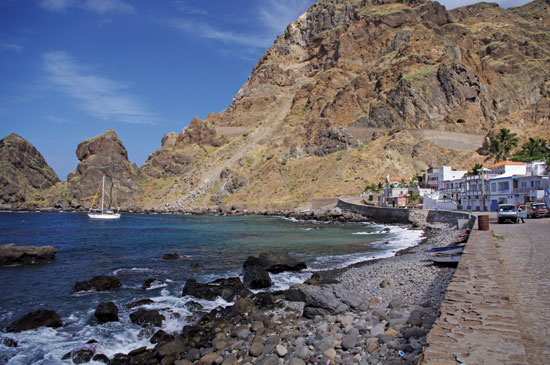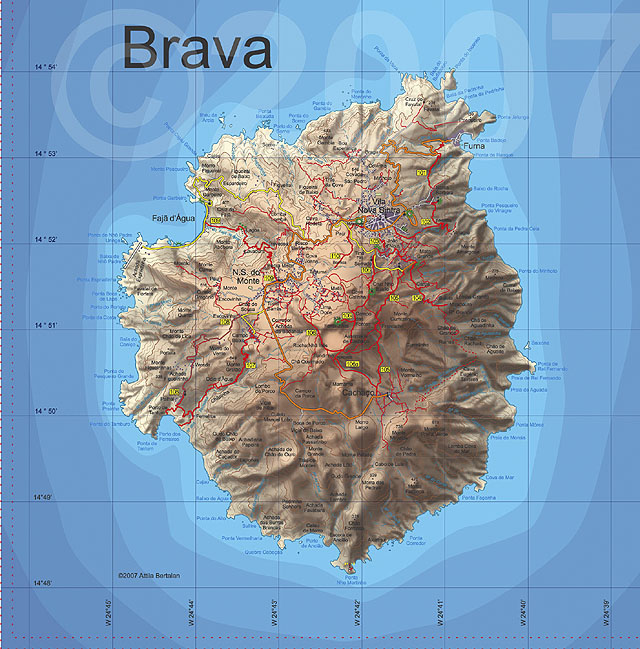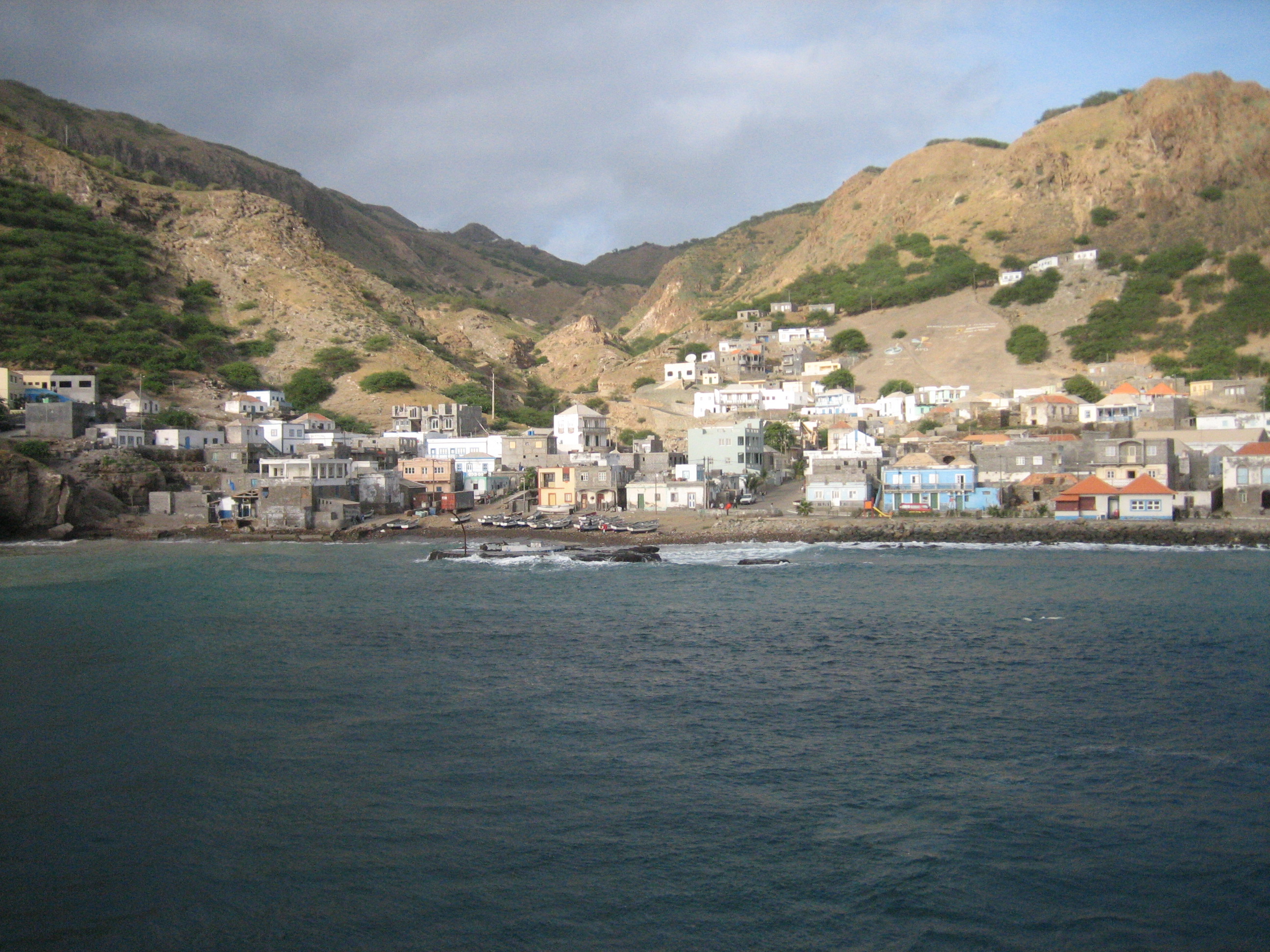Brava, Cape Verde
Brava (German: " the indomitable ") is the smallest of the inhabited Cape Verde islands in the Atlantic. It is almost circular with a diameter of max. 11 miles and an area of 67 km ².
Geography
The small, mittelgebirgige Island, in the extreme west of the island group Sotavento ( Leeward Islands ) west of Fogo. They reached with difficulty the necessary height to win some precipitation from the trade winds. However, since it is in the lee of the huge volcanic cone of Fogo, it is often covered by a Lee - cloud, so that the evaporation is lower and the vegetation a bit richer. The island is roughly circular and densely populated in the higher elevations. Here are also the island's capital, Vila Nova Sintra and the Sanctuary of Nossa Senhora do Monte. The fishing village Furna takes the role of a small ferry and trading port. Also located on the west side of the island bay at Faja de Água takes at certain seasons a true port function. The bay with the small fishing village, palm trees and jagged rocks is one of the most beautiful places on the island of Brava.
In several years of food -for-work - work in 1992, funded by Germany, also an airfield on the bay at Faja de Água created, abandoned because of the almost constantly blowing strong wind soon and not yet used (2005) again.
To the east of the island of Brava was with Vinagre a mineral spring, but dried up in the early 21st century.
Geology
The geological evolution of Brava can be divided into three vulkanostratigraphische units ( from young to old):
- Upper Unit
- Mean unit
- Lower unit
The lower unit consists of a 3 bis 2 million years BP old, submarine volcanic succession of the Pliocene ( Piacenzium to Gelasian ). It corresponds to the Seamountstadium in the development Bravas and built by Hyaloklastiten and pillow lava, which are traversed by innumerable transitional kogenetischen droves. Geochemical it This is Ankaramite and nephelinites. The lower unit was in the Early Pleistocene ( period 1,8 bis 1.3 million years BP) intruded by an alkaline plutonic rock / carbonatite complex of the middle unit consisting of pyroxenites, Ijolithen, nepheline syenites and carbonatites ( Söviten ). Between 1.3 and 0.25 million years BP, these two units were subjected to severe erosion and was formed for subsequent Upper unit a erosional. In the upper Middle Pleistocene 250,000 years ago BP then continued after a long break again volcanism one, which promoted mainly phonolithische rocks to light. It is characterized by explosive, phreatomagmatic and magmatic ejecta. Were formed pyroclastic flows (block and ash flows), pyroclastic ceilings with surge phenomena and countless caused by phreatic eruptions crater. Effusive lava flows and lava domes were formed.
A special Bravas is the occurrence of intrusive as extrusive carbonatites. The intrusive carbonatites are found in the plutonic Middle unit; they have a younger age than comparable deposits on Fogo, Santiago and Maio. Extrusiv to find jungpleistozäne to Holocene carbonatite in the upper unit and are unique to the Cape Verde Islands.
The presence of undersea deposited Hyaloklastiten and pillow lava, as well as raised beaches up to 400 meters above sea level clearly favors a lifting Bravas since Seamountstadium. Estimates show an uplift rate of 0.2 to 0.4 mm / year.
Brava is crossed by many faults, side shifts and volcanic / tectonic lineaments, which shaped the development of the island prevail. The Intrusivgänge the Lower Unit are orthogonal organized with a predominant east-west orientation. Disturbances in the two upper units follow mainly the north-north- west to northwest direction.
The spatial arrangement of faults corresponds more or less to the personnel encountered on the neighboring island of Fogo tension. Both islands and the Cadamosto - Seamount and the Ilheus do Rombo sit on the same base, which sits at a depth of around 4000 meters between 500 and 1000 meters thick marine sediments. The sediments overlie oceanic crust in turn from the Lower Cretaceous, which starts at about 5300 meters depth and extends to 13 km depth.
History
Brava was only in 1462 by the Portuguese and enter dawned his slumber to 1573 settled the first permanent settlers. At this time the peak of the slave trade in Cidade Velha ( Cape Verdean island of Santiago) had expired, so the Madeira and the Minho ( Northern Portugal) derived small farmers no longer involved. 1680 fled the inhabitants of the neighboring island of Fogo in front of the lava of the erupting volcano after Brava and reinforced the local population. The often anchored in the bays of Brava in the 17th and 18th century pirates ( among them Emanuel Wynne, who is said to have hoisted the Jolly Roger first ) were replaced in the early 19th century by whaling ships from Europe and the United States. In the moving still under sail Walschonern U.S. young men from Brava hired and thus formed the spearhead of a now almost two centuries persistent emigration to the American east coast, especially in the old whaling ports of Boston, Providence and New Bedford.
Brava has become famous by the musician and poet Eugénio Tavares, who created a new, first time confidently Cape Verdean music with its written in kapverdischem Creole, sad Mornas.
Economy and Tourism
Something irrigated agriculture ( mainly maize, beans, bananas and papayas ) and livestock ( most likely cows and goats) as well as artisanal fishing are the only significant branches of production. Trade, commerce and households live mainly on income from exile in the United States. The road network on Brava has been greatly improved in recent years - all settlements on the island are to reach, over paved roads and with the typical for the Cape Verde Islands " Aluguer " buses.
Since the ferry connections to Furna are somewhat regularly since 2004 and no flight connection exists, Brava has barely opened to tourism. The rare guests will appreciate the tranquility and seclusion of the island. Accommodations for tourists are located in Vila Nova Sintra, Faja de Água and Cova Joana. Thus, tourism has slowly begun and qualified, as the island is not suitable for the mass beach tourism.
Sons and daughters of the island
- Nilton Fernandes ( born 1979 ), football player
Cliffs in the north of the island Brava how often " Wolkenhut ". Helicopter shooting of 20 April 1994
The island of Brava is also called the island of flowers, because of the ubiquitous hibiscus flowers.
Island capital of Vila Nova Sintra on an average 480 m high plateau. In the background the island of Fogo, 20 km away
Bay and fishing village of Faja de Agua in the west of the island of Brava ( 1988)
The airfield of Brava in Faja de Água in a prominent location










